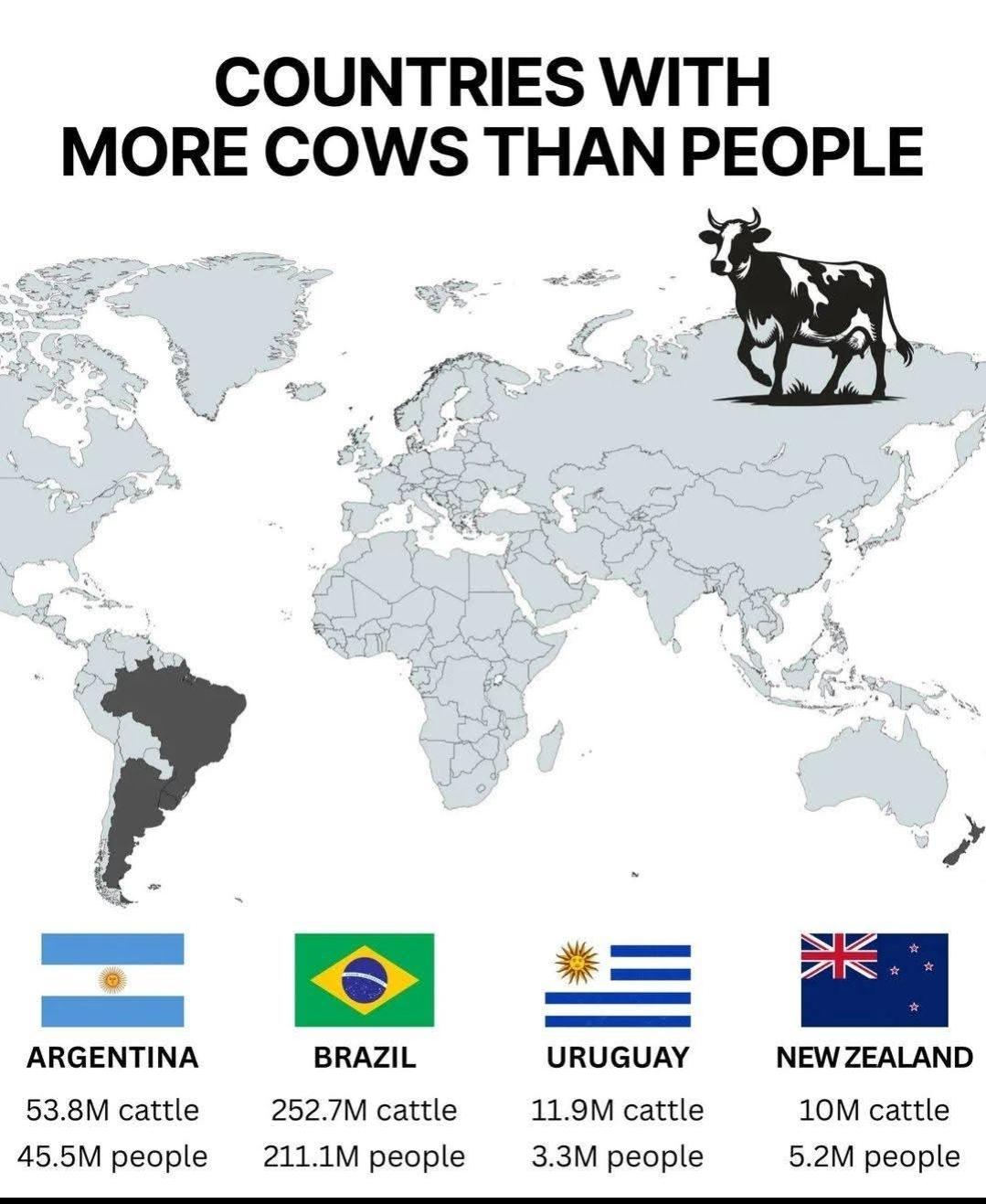Map of Countries with More Cows Than People


Alex Cartwright
Senior Cartographer & GIS Specialist
Alex Cartwright is a renowned cartographer and geographic information systems specialist with over 15 years of experience in spatial analysis and data...
Geographic Analysis
What This Map Shows
The visualization titled "Countries with More Cows Than People" gives us an intriguing glimpse into the relationship between livestock and human populations across various nations. It highlights countries where the bovine population exceeds that of humans, indicating unique agricultural practices, cultural significance, and economic dependencies on cattle farming.
Transitioning from the visualization, we can explore the broader topic of cattle farming and its implications globally. This phenomenon is not merely about numbers; it reflects the intricate dynamics of rural economies, land usage, and even dietary habits in different regions.
Deep Dive into Cattle Farming
Cattle farming, or bovine husbandry, is a cornerstone of agriculture in many parts of the world. Interestingly, the countries featured on this map often have vast expanses of land suited for grazing, which supports large herds of cattle. For instance, in nations like Brazil and Argentina, the cattle industry is not only a significant part of the local economy but also a cultural symbol. The tradition of cattle ranching dates back centuries, influencing everything from local cuisine to national identity.
Globally, the countries with more cows than people often have lower population densities. For example, in Mongolia, there are approximately 4.2 million cattle compared to a human population of just around 3.4 million. The vast steppes provide ample grazing land, making cattle ranching a vital part of the economy and lifestyle.
Moreover, the economic implications of having more cattle than humans are profound. In regions like South America, cattle farming contributes significantly to GDP, with beef exports making up a substantial portion of trade. Interestingly, in the United States, which also appears on this map, the beef industry is a multi-billion dollar sector, supporting not just ranchers but a plethora of industries from food processing to transportation.
On the flip side, cattle farming poses challenges such as land degradation, water scarcity, and greenhouse gas emissions. As the global population continues to rise, the demand for beef is expected to increase, leading to further pressure on these countries' resources. This presents a critical question: how can these nations balance the economic benefits of cattle farming with environmental sustainability?
Regional Analysis
Now, let’s break down the various regions represented on the map. In North America, the United States stands out with its massive cattle ranching operations. The Midwest, often referred to as the "breadbasket of America," is known for its extensive farms and ranches. Interestingly, the U.S. has a cattle-to-human ratio of about 1.5:1, making it one of the leading beef producers in the world.
In contrast, looking at South America, Brazil and Argentina dominate the landscape. Brazil is home to the largest cattle herd globally, with numbers exceeding 225 million. The Pampas region, characterized by rich, fertile soil, supports extensive cattle ranching. Argentina, known for its beef culture, also features prominently on this map, with a cattle population that surpasses its human count.
Moving to Africa, countries like Namibia and Botswana also appear on the map. These nations utilize cattle not just for meat but for cultural practices, such as the Himba people’s reliance on cattle in their traditional lifestyles. Here, cattle serve both economic and social functions, illustrating the deep-rooted connections between livestock and cultural identity.
Significance and Impact
Why is the relationship between cows and human populations important? The implications extend beyond agricultural practices. Understanding the dynamics of cattle farming can highlight issues such as food security, economic stability, and environmental sustainability. For instance, as these nations work to increase beef production, they must also consider the environmental impacts of overgrazing and land use change.
Current trends indicate a growing demand for beef globally, particularly in developing nations where rising incomes lead to changes in dietary preferences. Interestingly, this could exacerbate issues like deforestation and water scarcity, especially in regions already facing environmental challenges. As we look to the future, the need for sustainable practices in cattle farming has never been more critical.
In conclusion, the map of countries with more cows than people is more than a simple visualization; it opens a window into the complexities of agriculture, culture, and sustainability. By examining these relationships, we can better understand the challenges and opportunities that lie ahead for these nations and their cattle industries.
Visualization Details
- Published
- October 24, 2025
- Views
- 12
Comments
Loading comments...